|
A YEAR AGO, people worldwide—including
avowed non-sports fans—were glued to their televisions during
the World Cup in such a way that transcended the action on the field.
People got an extensive look at how Nelson Mandela’s vision
of coexistence and openness toward other cultures could exist in
the real world and in real time.
Many of us came of age when Nelson Mandela was released
from nearly three decades in prison in 1990. From prison through
his presidency, people were inspired by the epic journey he and
other countrymen experienced that encompassed sacrificed freedom,
diligent plotting to dismantle the institutionalized racism of apartheid
and the foundation of a new constitution. In the 22 years following
his release, this excitement hit several high points: his election
as president, the 1995 Rugby World Cup that inspired the acclaimed
Clint Eastwood film Invictus, and last year’s World
Cup which united the tumultuous world of 2010 for one brief but
outstanding moment in time.
While Mandela retired and passed the baton to a new
generation of leaders in 1999, we still revere the accomplishments
he will forever be associated with. Though life has also gone on
in the months following the World Cup broadcasts, the allure of
the New South Africa’s spirit is stronger than ever. The energy
is palpable, from the nation’s multicultural urban hubs (Cape
Town in particular) to the eternal appeal of safaris—the original,
and perhaps the most authentic, form of eco-tourism.
In order to appreciate the new South Africa in earnest,
one has to acknowledge wounds inflicted by apartheid are still in
the healing stages. Townships and poverty still skirt the perimeters
of cities. Some white citizens express views that register as out
of date and out of sync. Many Cape Town cultural institutions, such
as Robben Island, the District Six Museum, the Iziko Slave Lodge,
the Jewish Museum and even changing exhibits at the Iziko South
African National Gallery, all pack an emotional punch in visually
relaying first-hand accounts of individuals who did what was right
and not what was popular.
| From that seed emerged the Amarula Trust,
and if one travels to the Amarula Lapa during their summer months,
one can see first-hand its conservation efforts and
community philanthropy in action |
Robben Island’s docents are former inmates such
as Sedeeq Levy, who during the tour expressed that his choice of
vocation is based on the collective goal of former inmates to present
the former prison to the world as a living legacy for post-apartheid
South Africa, standing for peace and love as well as the hate that
put them there. The Jewish Museum dedicates a significant amount
of its space to Opposition Party leader Helen Suzman, and other
Jews in politics and law, who put their lives and reputations on
the line to support the cause. The Iziko South African National
Gallery juxtaposed its stunning permanent art collection with a
profoundly moving temporary exhibit on Ernest Cole, whose photographic
documentation of apartheid gave the rest of the world its first
look at the old régime’s atrocities in 1968. Even with
an internationally acclaimed book House of Bondage, Cole
paid for his conviction with a life in exile.
With South African culture and lifestyle in its proper
perspective, Cape Town and safari lodges resorts like Kapama Private
Game Reserve near Hoedspruit (on the outskirts of Kruger National
Park) represent aspects of what’s right about this country,
especially as they showcase an emergence of a distinctively South
African foodie culture, fashion scene and home design. Multiculturalism
is celebrated both on a grand scale and everyday life. Firms like
Distell (parent company of Amarula liqueur, Van Ryn brandy and several
internationally distributed wines including Durbanville Hills, Nederburg
and Fleur du Cap) contribute significantly to neighbouring communities
of their distillery and wineries.
Though convening with nature at Kruger National Park’s
environs is essential, a visit to the Amarula Lapa (visitor centre)
near Phalaborwa adds an added dimension of authenticity to experiencing
that end of South Africa. The marula fruit (which, freshly picked,
comes off as an eccentric hybrid of citrus, passion fruit and plum)
has provided nourishment to elephants and humans for centuries.
On a small scale, locals have used its components to manufacture
local beer, fruit juice and beauty products. However, the economics
of this fruit expanded nearly 20 years ago when Distell’s
experiments to develop a marula spirit with international appeal,
in a matter of speaking, bore fruit.
From that seed emerged the Amarula
Trust, and if one travels to the Amarula Lapa during their summer
months, one can see first-hand its conservation efforts and community
philanthropy in action. During the months the villages’ husbands
are stationed at their jobs, the trust provides wives supplemental
household income through seasonal work, as well as a medical facility
and day care centre. The trust also has a scholarship programme,
enabling young adults to further their education and train for field
guide careers.
continued
|  |

Robben Island
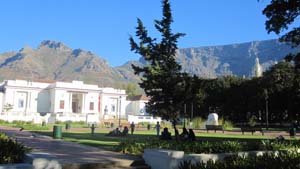
Iziko Museum
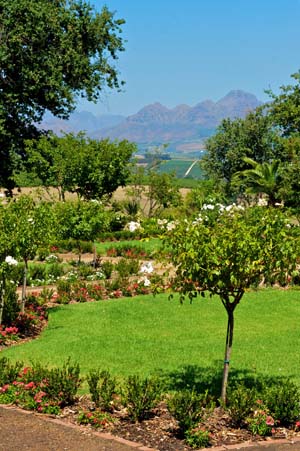
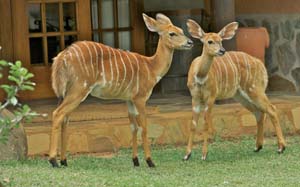
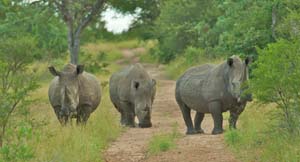
Paul J. Coffin
South African winelands, nyalas and rhinoceros

Kapama Lodge suite
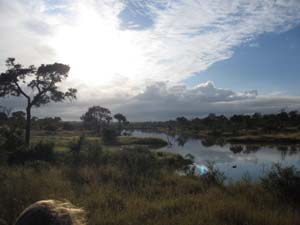
Sunrise from Kapama Lodge
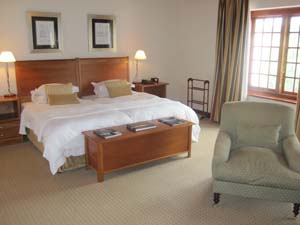
Steenberg Hotel suite

Tapas at Sixteen82
|

